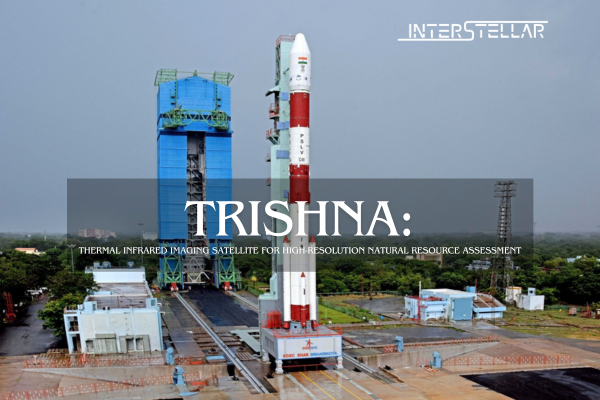The TRISHNA (Thermal Infra-Red Imaging Satellite for High-resolution Natural Resource Assessment) mission is a joint initiative by ISRO and CNES. This mission aims to provide high-resolution monitoring of Earth’s surface temperature, emissivity, biophysical variables, and radiation for energy budgeting on a regional to global scale. It focuses on addressing water and food security challenges, human-induced climate change impacts, and efficient water resource management through evapotranspiration monitoring.
Primary Objectives
TRISHNA’s main goals include:
- Detailed monitoring of the energy and water budgets of the continental biosphere to quantify terrestrial water stress and usage.
- High-resolution observation of water quality and dynamics in coastal and inland waters.
Secondary Objectives
The mission also aims to:
- Assess urban heat islands.
- Detect thermal anomalies related to volcanic activity and geothermal resources.
- Monitor snow-melt runoff and glacier dynamics.
- Provide data on aerosol optical depth, atmospheric water vapor, and cloud cover.
Benefits of TRISHNA
The TRISHNA mission offers extensive scientific and societal benefits, such as:
- Agricultural Water Management: TRISHNA will help assess irrigation water use, advise on water savings, and enhance crop water productivity. It will support sustainable water management practices and improve micro-watershed management.
- Climate Monitoring: The mission will track key indicators like droughts, permafrost changes, and evapotranspiration rates.
- Urban Planning: Urban planners will benefit from detailed maps of urban heat islands and heat alerts.
- Water Quality Monitoring: TRISHNA will detect pollution in coastal and inland water bodies and identify sub-marine groundwater discharge at coastal fringes.
- Geothermal Resources and Cryosphere Monitoring: It will help detect sub-surface fires, assess geothermal resources, and evaluate snow cover and snow-melt patterns, aiding hydrological models.
TRISHNA Satellite Details
The TRISHNA satellite is equipped with two primary payloads:
- Thermal Infra-Red (TIR) Payload: Provided by CNES, this includes a four-channel long-wave infrared imaging sensor for high-resolution surface temperature and emissivity mapping.
- Visible – Near Infra-Red – Short Wave Infra-Red (VNIR-SWIR) Payload: Developed by ISRO, this has seven spectral bands designed for detailed mapping of surface reflectance and biophysical variables.
The satellite will operate in a sun-synchronous orbit at an altitude of 761 km, with a local time of 12:30 PM at the equator. This orbit offers a spatial resolution of 57 meters for land and coastal areas and 1 km for oceanic and polar regions. The mission is designed for a five-year operational life.
Global Contributions
TRISHNA’s data will support several global initiatives, including:
- GEOGLAM for agricultural monitoring.
- The UN’s Sustainable Development Goals.
- The Global Water Watch.
The mission’s outputs will serve as Essential Agricultural Variables (EAVs) and Essential Climate Variables (ECVs) for the global community.
Conclusion
The TRISHNA mission represents a significant advancement in remote sensing technology. It addresses critical water and food security issues and provides essential data to support sustainable solutions for policymakers, watershed managers, agro-industries, and the farming community. With its high-resolution and high-repeat imaging capabilities, TRISHNA will enhance our understanding of Earth’s natural processes and support global efforts in climate change mitigation through optimised resource management.


